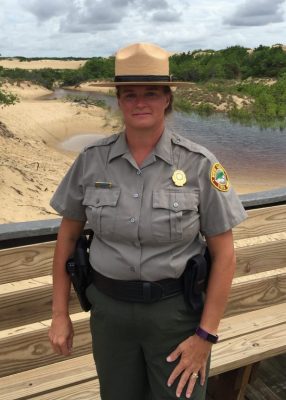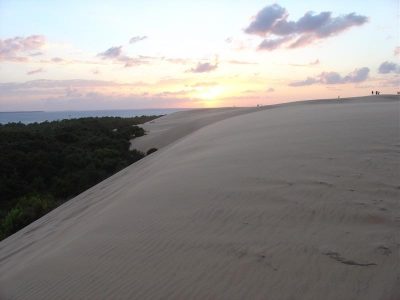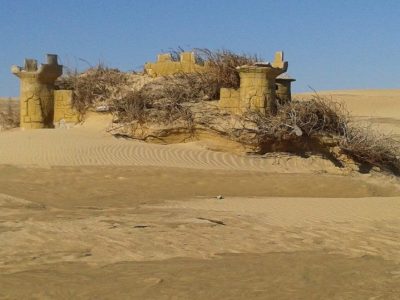NAGS HEAD – To the majority of the million visitors who trek up the big dune at Jockey’s Ridge State Park every year, they may believe that Joy Greenwood is in charge of a giant pile of hot sand.

Greenwood, the new superintendent of one of the most popular destinations on the Outer Banks, knows all too well that Jockey’s Ridge is a natural phenomenon of curious complexity, surprisingly harsh conditions and ever-changing beauty.
Supporter Spotlight
“It’s the tallest, active, living sand dune,” Greenwood explained, chatting amiably during a recent interview at her office. “What that means is it’s still getting sand.”
Sand is what Jockey’s Ridge is all about, and Greenwood, naturally, knows her subject. Off the top of her head, she cited some unexpected facts. The composition of the estimated 30 million tons of sand in the park is not like the beach sand with its ground-up seashells. Jockey’s Ridge’s sand is 90 percent quartz, very fine and deposited from the air. And all of it originated millions of years ago from the North Carolina mountains.
As Jockey Ridge’s third park superintendent – and its first female – Greenwood, 46 and a native of Vernon, New Jersey, is inheriting a dynamic charge at a place known for its extremes: weather, natural resources and visitation.
“Jockey’s Ridge is three different environments in one place,” George Barnes, the park’s first superintendent who served a total of 31 years, recently said. “There’s a lot to learn over there that people don’t know about. It’s more than a big sand dune.”
The backside of the park runs along Roanoke Sound and includes a popular swimming beach and marked hiking trails through thickets of red cedar, wax myrtle, live oaks and bayberry.
Supporter Spotlight
As a veteran of state parks since 1998, Greenwood most recently served as superintendent of Merchants Millpond State Park in Gates County. She has also worked as a ranger at Goose Creek State Park in Beaufort County and Pettigrew and Dismal Swamp state parks, in Tyrrell and Washington counties and Camden County, respectively. She was named superintendent at Dismal Swamp State Park in 2007. She earned a bachelor’s degree in biology from East Carolina University in 1993.
Greenwood, who is also a fitness instructor for law enforcement officers, succeeded former superintendent Debo Cox in December.
“As far as resource management, she is top notch,” Barnes said of Greenwood. “She is a real people person. I think she’ll do a great job.”

Statewide, the park is usually the third- or fourth-most visited, taking turns with Fort Macon State Park in Carteret County. But both parks are within a few thousand visitors of the other, averaging about 1.3 million annual visitors. First and second place usually go to William B. Umstead and Jordan Lake parks, which each average about 1.5 million visitors a year.
Jockey’s Ridge, situated in the middle of Nags Head and essentially midway on the Outer Banks, is an irresistible draw to the countless tourists who either intentionally visit to climb the dune, or decide on a whim to stop as they’re passing by on U.S. 158. Although the official entrance to the 426-acre park is located about a half-mile north, the majority of visitors park at a shopping center across the street from the dune, and cross the highway at a stoplight the state installed a number of years ago.
“On Memorial Day weekend, we had about 8,000 visitors in a day,” Greenwood said. But that’s not unusual once the summer kicks in full bore, when an average of 7,000 to 10,000 people a day visit. “A lot of people come for the sunsets.”
What many people don’t realize is that how difficult, and even disorienting, climbing the ridge can be. Once on top, the endless sand makes it difficult to find one’s bearings. And on hot summer days, the sand can be as much as 30 to 40 degrees hotter than the air temperature – and there is no water fountain or shade to be found.
“Heat emergencies are one of the biggest emergencies we deal with,” Greenwood said. “What the staff has been doing now is taking ice runs … and we do have signs to warn people to bring water. Fortunately, our ranger staff are pretty on top of things.”
It is not in the imagination of keen observers that the famous tall dune is getting a little stubbier, Greenwood said. When the park was established in 1975, the dune was a single, large dune that was about 140 feet. Today, it has evolved into three smaller dunes, ranging between 80 feet and 90 feet in height.
But that constantly moving sand can sometimes cause problems.
As Greenwood explained it, the predominant winds at the park blow from the northeast in the winter, and from the southwest in the summer. But the winter winds are just a little bit stronger, moving the sand dune 1-6 feet a year toward the south. As a result, sand has twice strayed onto the roadway and had to be moved.
A project planned for the winter of 2018-19 is intended to remove sand from the southeast corner of the park, where it is starting to encroach Soundside Road. A similar project also had to be done in 2004, when 10,000 dump-truck loads of sand were hauled off from the southwest corner of the park.

In the process of the upcoming project, the exposed “castle” that is visible from the road may have to be removed if too much sand must be taken. The attention-getting castle, which has been buried and unburied over the years, is the remains of a mini-golf course that once covered 3 acres of the 426-acre park.
“We’re going to do our best to not take it away,” Greenwood said. “It is sort of an informal historical landmark.”
Greenwood, who oversees a staff of six, will soon be supervising the park’s first exhibits upgrade since 1994. A designer is expected to start work on the project by year’s end, and it should be completed by early 2019.
As a former employee of a windsurfing shop in Avon, Greenwood is enjoying her return to the Outer Banks, albeit in a more serious way. Her parents have retired here, and she is a mother of three. She and her husband, who is the State Parks’ regional superintendent for the Piedmont, are kayak instructors for the American Canoe Association.
“The most recent thing we’ve done (to celebrate their 15th wedding anniversary) is paddled from Jockey’s Ridge to Manteo,” she said. “It’s 7 miles, round-trip. It took about two hours to get over and about one and a half hours to get back.”







